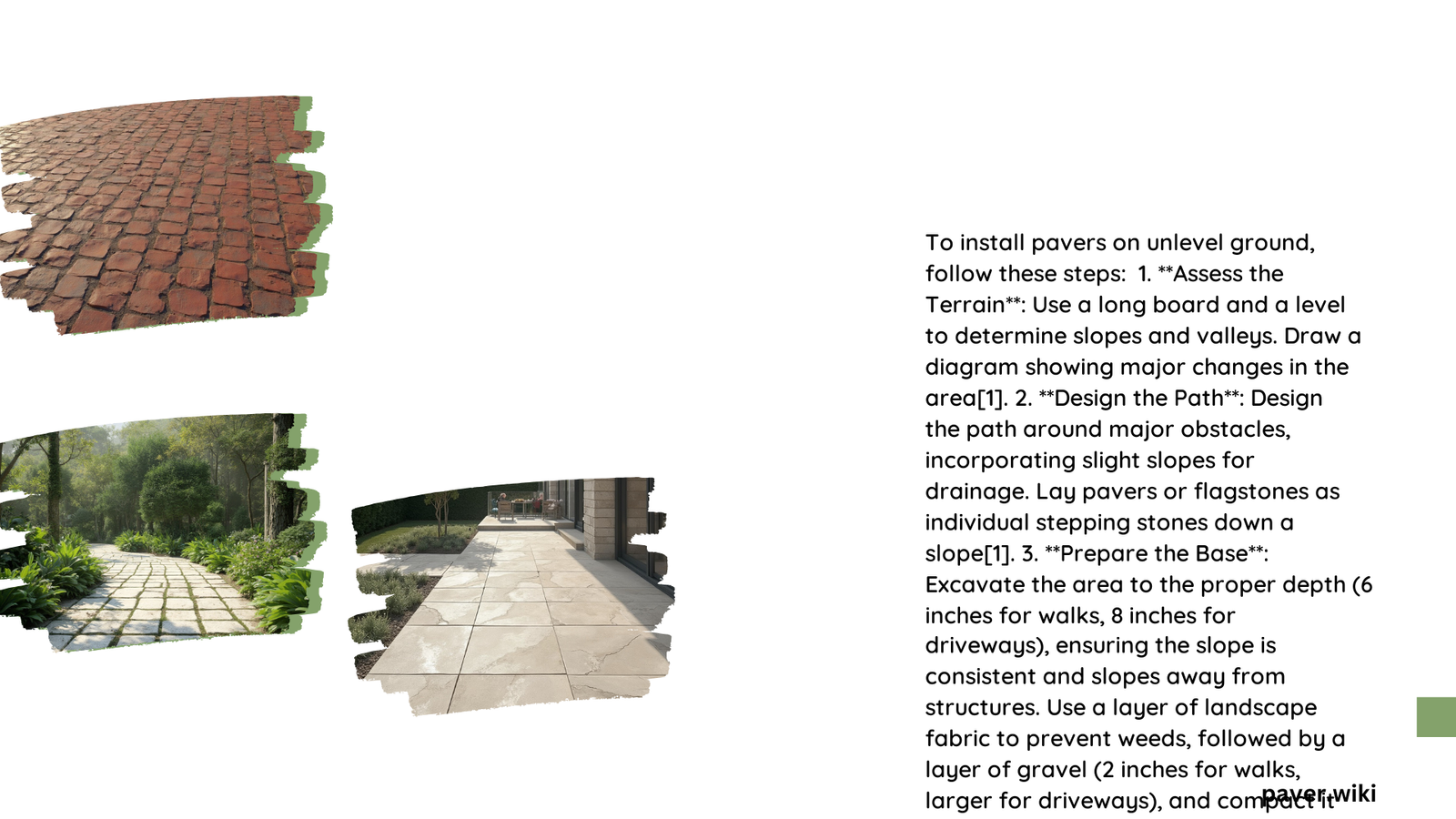Installing pavers on unlevel ground presents unique challenges but can be achieved with proper techniques. This comprehensive guide covers essential steps for preparing uneven terrain, selecting appropriate materials, and ensuring proper drainage. From assessing the site to final installation, learn how to create a stable, visually appealing paved surface on sloped or irregular landscapes.
What Are the Key Challenges of Installing Pavers on Unlevel Ground?
Installing pavers on unlevel ground poses several challenges:
- Ensuring proper drainage
- Maintaining stability of the pavers
- Creating a level surface on sloped terrain
- Preventing settling and shifting over time
To overcome these challenges, careful planning and execution are crucial.
How to Assess the Terrain for Paver Installation?

Before beginning the installation process, a thorough assessment of the terrain is essential:
- Use a long board and level to identify slopes and valleys
- Create a detailed diagram showing major changes in the area
- Measure the overall slope to determine drainage requirements
- Identify any obstacles or features that may affect the installation
This assessment will guide your excavation and base preparation strategies.
What Are the Steps for Preparing Unlevel Ground for Pavers?
Preparing unlevel ground for pavers involves several critical steps:
- Excavation:
- Dig to a depth of 6-8 inches for walkways and patios
-
For driveways or areas with heavy loads, excavate to 8 inches or deeper
-
Base Preparation:
- Lay landscape fabric to prevent weed growth and soil mixing
- Add a 4-6 inch layer of crushed gravel (3/4 minus)
-
Compact the gravel in layers using a plate compactor
-
Sand Bedding:
- Spread a 1-2 inch layer of sand over the compacted gravel
-
Lightly compact the sand to create a stable base
-
Leveling:
- Use a long board and level to ensure the base is even
- Make adjustments as needed to create a level surface
What Tools Are Required for Installing Pavers on Unlevel Ground?
To successfully install pavers on unlevel ground, you’ll need the following tools:
- Shovel or rented excavator
- Measuring tape
- String and stakes
- Plate compactor
- Spirit level
- Rubber mallet
- Landscape fabric
- Wheelbarrow
- Garden rake
- Steel tamper or hand tamper
Having the right tools will make the installation process smoother and more efficient.
How to Ensure Proper Drainage for Pavers on Sloped Terrain?
Proper drainage is crucial when installing pavers on sloped terrain:
- Slope Requirements:
-
Create a slope of 1 inch for every 4 feet away from structures
-
Drainage Channels:
-
Install swales or French drains to direct water away from the paved area
-
Permeable Pavers:
-
Consider using permeable pavers to allow water to pass through
-
Base Material Selection:
- Use crushed gravel as a base to facilitate drainage
| Drainage Solution | Description | Best For |
|---|---|---|
| Slope | 1 inch per 4 feet | General drainage |
| Swales | Shallow depressions | Redirecting surface water |
| French Drains | Gravel-filled trenches with pipes | Areas with significant drainage issues |
| Permeable Pavers | Allow water to pass through | Reducing water pooling |
What Are the Best Practices for Laying Pavers on Uneven Ground?
Follow these best practices when laying pavers on uneven ground:
- Start from a corner or edge, using string lines for guidance
- Use a rubber mallet to tap pavers firmly into place
- Check level frequently with a spirit level
- Maintain even spacing between pavers
- Install edge restraints to prevent displacement
- Fill gaps with polymeric sand for added stability
Adhering to these practices will help ensure a stable and visually appealing result.
How to Address Steep Slopes When Installing Pavers?
For steeper slopes, consider the following techniques:
- Terracing:
-
Create level areas separated by short retaining walls
-
Steps:
-
Build steps 30-36 inches wide, 11-12 inches deep, and 7-9.5 inches high
-
Gradual Transitions:
-
Use long, gentle slopes leading to short steps for less steep areas
-
Reinforced Base:
- Increase the depth of the base material for added stability
These methods help manage steep slopes while creating functional and attractive paved surfaces.
What Are the Common Mistakes to Avoid When Installing Pavers on Unlevel Ground?
Avoid these common mistakes when installing pavers on unlevel ground:
- Inadequate base preparation
- Ignoring proper drainage
- Failing to compact base materials sufficiently
- Not using edge restraints
- Neglecting to account for settling over time
- Improper slope for water runoff
By being aware of these pitfalls, you can ensure a more successful paver installation on challenging terrain.
How to Maintain Pavers Installed on Unlevel Ground?
Proper maintenance is key to the longevity of pavers installed on unlevel ground:
- Regularly inspect for settling or shifting
- Clean the surface to prevent weed growth and staining
- Reapply polymeric sand as needed to maintain joint stability
- Address any drainage issues promptly
- Seal the pavers every 3-5 years for added protection
Following these maintenance practices will help preserve the beauty and functionality of your paved surface.
By following this comprehensive guide, you can successfully install pavers on unlevel ground, creating a stable, attractive, and long-lasting surface for your outdoor space.
References:
1. How to Install Pavers on Unlevel Ground
2. How to Level Ground for Pavers
3. 10-Step Guide to Installing Pavers
